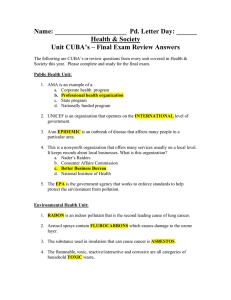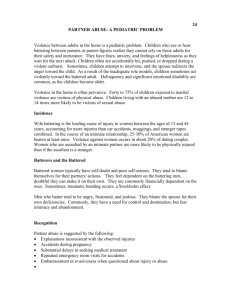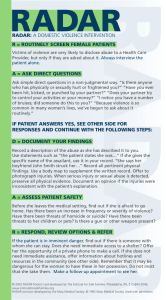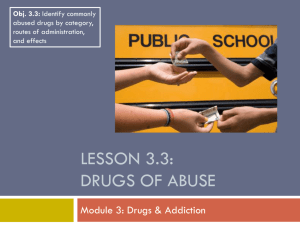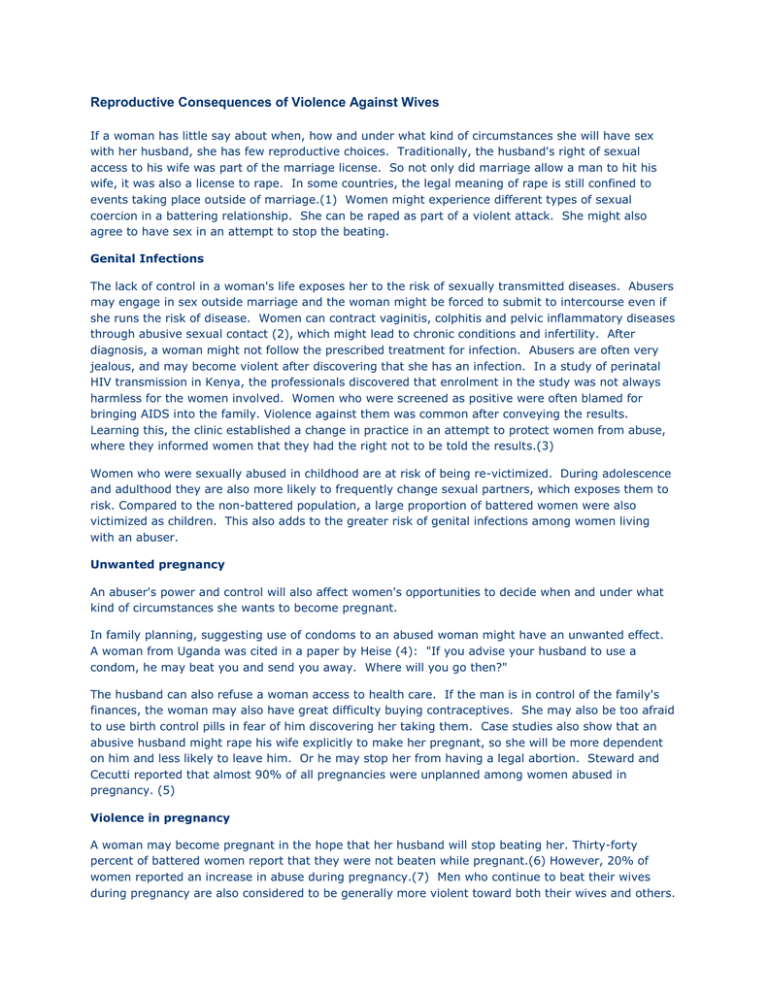
Reproductive Consequences of Violence Against Wives
If a woman has little say about when, how and under what kind of circumstances she will have sex
with her husband, she has few reproductive choices. Traditionally, the husband's right of sexual
access to his wife was part of the marriage license. So not only did marriage allow a man to hit his
wife, it was also a license to rape. In some countries, the legal meaning of rape is still confined to
events taking place outside of marriage.(1) Women might experience different types of sexual
coercion in a battering relationship. She can be raped as part of a violent attack. She might also
agree to have sex in an attempt to stop the beating.
Genital Infections
The lack of control in a woman's life exposes her to the risk of sexually transmitted diseases. Abusers
may engage in sex outside marriage and the woman might be forced to submit to intercourse even if
she runs the risk of disease. Women can contract vaginitis, colphitis and pelvic inflammatory diseases
through abusive sexual contact (2), which might lead to chronic conditions and infertility. After
diagnosis, a woman might not follow the prescribed treatment for infection. Abusers are often very
jealous, and may become violent after discovering that she has an infection. In a study of perinatal
HIV transmission in Kenya, the professionals discovered that enrolment in the study was not always
harmless for the women involved. Women who were screened as positive were often blamed for
bringing AIDS into the family. Violence against them was common after conveying the results.
Learning this, the clinic established a change in practice in an attempt to protect women from abuse,
where they informed women that they had the right not to be told the results.(3)
Women who were sexually abused in childhood are at risk of being re-victimized. During adolescence
and adulthood they are also more likely to frequently change sexual partners, which exposes them to
risk. Compared to the non-battered population, a large proportion of battered women were also
victimized as children. This also adds to the greater risk of genital infections among women living
with an abuser.
Unwanted pregnancy
An abuser's power and control will also affect women's opportunities to decide when and under what
kind of circumstances she wants to become pregnant.
In family planning, suggesting use of condoms to an abused woman might have an unwanted effect.
A woman from Uganda was cited in a paper by Heise (4): "If you advise your husband to use a
condom, he may beat you and send you away. Where will you go then?"
The husband can also refuse a woman access to health care. If the man is in control of the family's
finances, the woman may also have great difficulty buying contraceptives. She may also be too afraid
to use birth control pills in fear of him discovering her taking them. Case studies also show that an
abusive husband might rape his wife explicitly to make her pregnant, so she will be more dependent
on him and less likely to leave him. Or he may stop her from having a legal abortion. Steward and
Cecutti reported that almost 90% of all pregnancies were unplanned among women abused in
pregnancy. (5)
Violence in pregnancy
A woman may become pregnant in the hope that her husband will stop beating her. Thirty-forty
percent of battered women report that they were not beaten while pregnant.(6) However, 20% of
women reported an increase in abuse during pregnancy.(7) Men who continue to beat their wives
during pregnancy are also considered to be generally more violent toward both their wives and others.
(8) In a recent review of studies of prevalence of violence against pregnant women (9), thirteen
studies were found, all but one from North America. The reported rates were between 0.9 to 20.1%
(10). The lowest rate was reported by women attending a private clinic and responding to a selfadministered questionnaire. The authors concluded that despite the limitations of the studies, there
was a reason to believe that violence may be a more common problem for pregnant women than
preeclampsia, gestational diabetes, or placenta previa, conditions for which pregnant women are
routinely screened and evaluated.
When a pregnant woman is subjected to violence, it is certainly a threat to her own health, but it also
puts the fetus at risk. There are case histories describing "the battered fetus" syndrome as a cause of
perinatal death.(10) Interpersonal violence in pregnancy is also the cause of injuries in newborn
children. (11) Several studies have demonstrated that physical abuse is associated with a range of
adverse perinatal outcomes, such as premature births and low birth weight. (12) Stress- related
factors, genital infections and direct physical injuries may cause adverse effects in the newborn child.
A woman's ability to protect herself and her unborn baby is limited by the abuser. Abused women
report alcohol and drug abuse, cigarette smoking, and insufficient nourishment. These factors might
also influence the health of the unborn child. Psychological problems and thoughts of suicide are
prevalent among pregnant women who are abused. (13)
How to face violence as obstetrician-gynaecologists ?
General considerations
Violence is a painful side of women's lives which is hard to face. There are still large gaps in the
education and training of health care professionals (14), which may result in them feeling helpless and
reluctant to face the problem. It is important to bear in mind that overlooking abuse might lead to a
poor quality of diagnosis and evaluation in our daily work.
In order to increase our knowledge and skills in this area all physicians studying obstetrics
gynaecology should be offered postgraduate training. All patients should be given general information
with detailed descriptions of legal rights, shelters and services for battered women in the region. The
problems of violence cannot be resolved within the medical setting. In many parts of the world,
shelters for battered women and networks against violence have been established. Collaboration
should be established between reproductive health services and services outside the hospital/clinic.
There is also a great need to develop best practice models within the health care system.
Obstetrician-gynaecologists might refrain from facing the problem because they lack referral systems
and resources in the community to address violence. It is important to remember that most battered
women hope that someone will ask them about the abuse. For an abused woman, facing a caring
obstetrician-gynaecologist who has knowledge of abuse may be the first step toward changing her
situation. The following are some key issues to be taken into account in everyday practice:
Gynaecological encounters
Consultation should always involve careful, active listening in a safe environment, in order to
allow a woman to disclose.
Abused women are over-represented among several diagnostic groups. Women with these
disorders (e.g. chronic pelvic pain, pelvic inflammatory disease, and sexually transmitted
diseases) must be carefully examined for a history of abuse.
Psychological problems, Post Traumatic Stress Disorder (PTSD), suicide attempts, injuries and
"unexplained" somatic symptoms raise the suspicion of abuse.
Abused women might have problems following certain types of treatments such as antibiotics,
because they are afraid they will be suspected of extramarital sex, and beaten for it.
It might be difficult for abused women to inform their husband that they have tested HIVpositive.
Memories of severe trauma might be triggered by the gynaecological examination.
An abused woman might be more severely beaten if the husband knows she has disclosed
abuse.
Contraceptive advice must take into account the woman's ability to control her own sex life.
Antenatal care
A pregnant woman should have an opportunity to communicate in the absence of the spouse.
High risk women (eg. women with comorbidity, certain pregnancy complications and disorders in
pregnancy) should be assessed for abuse.
Assess abuse when medical advice and treatments assume that a woman's sexual partner will be
cooperative with treatment.
If a woman is abused in pregnancy, assess the danger and help her make individual safety plans.
Concluding Remarks
We, as obstetrician-gynaecologists, are important in the work to end violence against women. By
recognizing abuse as a problem, we can, in our daily work, help to change a woman's life. By
acknowledging that it is our professional responsibility, to respond to violence, we can work to
improve education and training in this area. By being advocates for abused women in society, we can
work to improve the services and resources for abused women. By saying 'no' to violence, we are
contributing to the long-term goal to end violence against women.
Based upon a presentation at the World Congress in Obstetrics and Gynecology (Fi60), Copenhagen,
1997
References
1. Russel, D.E.H. (1982). Rape in Marriage. (New York: Colliers Books, Macmillan Publishing
Company).
2. Schei, B. (1991). "Physically abusive spouse-a risk factor of pelvic inflammatory diseases?". Scand,
J. Prim. Health Care, 9, 41-5.
3. Temmerman, M., et. al. (1995). "The right not to know HIV-test results" Lancet, 345, 969-70.
4. Heise, L. (1993). Reproductive freedom and violence against women: Where are the intersections?
J.Law.Medicine and Ethics. 21,206-16..
5. Steward, D. & A. Cecutti. (1993). Physical abuse in pregnancy. Can.Med.Assoc., 149, 1257-69.
6. Schei,B.(1990). Trapped in painful love. Physical and sexual abuse by spouse-a risk factor of
gynaecological disorders and adverse perinatal outcomes Series A: Dissertation No 63.
(Trondheim:Tapir).
7. Hilard, P.J. (1985). "Physical abuse in pregnancy". Obstet. Gynecol., 66,185-90.
8. Fagen, J.A., K.S. Douglas & K.V. Hansen. (1983). "Violent men or violent husbands, background
factors and situational correlates". In Finkelhor, D., et. al. (eds.) The dark sides of families.(London:
Sage Publications), 49-69.
9.Gazmararian, J.A., et. al. (1996). "Prevalence of violence against pregnant women". J.A.M.A.,
275,1915-20
10. Morey, M.A., D.J. Begleiter, & D.J. Harris. (1981). "Profile of the battered fetus". Lancet, ii, 12956.
11. Goodwin, T.M. & M.T. Breen. (1990). "Pregnancy outcomes and fetomaternal haemorrhage after
noncatastrophic trauma". Am.J.Obstet.Gynecol., 162, 665-71.
12. Newberger, E.N., et. al. (1992). "Abuse of pregnant women and adverse outcome. Current
knowledge and implications for practice". J.A.M.A., 267, 1212-3.
13. Steward, D. & A. Cecutti (1993). "Physical abuse in pregnancy". Can.Med.Assoc., 149, 1257-69.
14. Chambliss, L.R., C.R. Bay, & R.F. Jones III. (1995). Am .J. Obstet. Gynecol., 172, 1035-8.
Resource details:
Author: Dr. Berit Schei, Atkinson Chair in Women's Health Research
Based upon a presentation at the World Congress in Obstetrics and Gynecology (Fi60), Copenhagen,
1997
Type/Format of Resource: Article
Category/Topic of interest: Woman Abuse
Population Group: Health Care Service Providers; Pregnant Women
Language of Resource: English
Year of Publication: 1995-1999
Contact Information:
Program Manager
Springtide Resources
t- 416-968-3422
f- 416-968-2026
info@springtideresources.org
http://www.springtideresources.org



